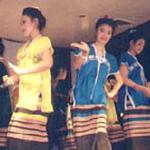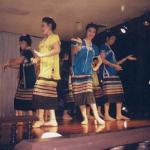You Can Eat More Than Just Rice in the Land of the Million Rice-fields
The borders of present-day Thailand encompass portions of at least three former kingdoms: Siam (capital Ayutthaya); Lan Xang (capital Luang Prabang); and Lan Na, or Land of the Million Rice-fields (capital Chiang Mai). Each had their own rulers, languages, styles of dress; and each had their own distinctive cuisine. Of course, certain ingredients and methods of preparation were common, as they are to Southeast Asia as a whole; but Lan Na food tends to be meatier and richer, given the region's remove from the ocean and its relatively cool climate. Obviously Thai food has been homogenized to a certain extent, especially in the cities, so that the origins of a dish are not always clear. A "Thai" restaurant in Chiang Mai will serve dishes from many regions of Thailand, as well as from many regions of the world: macaroni, Western salads, and tiramisu, for example.
Chiang Mai nevertheless affords many tastes of old Lan Na, a good introduction to which is the food and entertainment extravaganza known as a khantoke dinner. This is offered at, among other places, the Old Chiangmai Cultural Center on Wualai Road, between the airport and the walled old city. 270 baht gets you a two-to-four-person meal, free extra helpings, and the opportunity to view a series of Thai dances performed on a nearby stage. The dances include the Lan Na mahn mui chiangta, noi jaiya, and sword dances; and the celebrating dance of the Karen hill-tribe, indigenous to the north.
The toke of khantoke is a circular table no more than two feet high, on the top of which are many khan, or hand-size bowls. Each bowl contains a different delicacy. The meal also includes a small, woven canister packed with kao niew, glutinous or "sticky" rice; a pot of kao sooay, or steamed rice; a bowl of broth; and ice water. Alcoholic drinks, at least at the OCMCC, are quite expensive (150 baht for a small beer), but seemingly not a whit less consumed by the tourists.
The several khan display a wide sampling of Lan Na cuisine: fried chicken (gai tort); crispy pork (kap moo), a.k.a. pork rinds; gaeng hung lay, a Burmese-influenced curry of tender pork meat and fat, with ginger, tamarind, turmeric, and pickled garlic; nam prik orng, a spicy sauce of minced pork, tomato, chili, garlic, and shrimp paste, served cold -- Bolognese with a bite. Two other khan contain sweets: one of deep-fried bananas (glooay tort), another of carmelized crunchy rice noodles, tasting like a salty Rice Krispie Treat. A final khan contains a Chinese-style stew of cabbage and carrots. In the center of the ring of khan is a large bowl of raw cabbage and serrated cucumber slices, which are used along with rice to cool the palate. Dessert consists of a plate of rice cakes, and complimentary coffee or tea.
Almost needless to say, the khantoke is shared and eaten while sitting. To lessen the strain on one's back, triangle-shaped cushions (morn sahm liam) are generally provided. Plate, spoon, and fork are available, though much of the food can be eaten by hand.
Though you may be surfeited by the khantoke dinner, it may not feature every Lan Na dish, and their authenticity will depend on how touristed the locale. Roughly speaking, the farther the eatery from Chiang Mai, the more Lan Na the food. One indicator of Lan Na territory is the increasing prevalence of Lan Na script, a loopier cousin of Thai.
Still, Lan Na food can be found in Chiang Mai's restaurants, roadside stalls, and fresh markets; and in profusion at the city's annual food fest, taking place every November. But it is found most readily in the city's one-stop-shopping food pavilions: Galare Food Center and The Peak, both at the Night Bazaar; the Lanna Food Pavilion at Airport Plaza; and the Central shopping mall. These pavilions showcase just about every kind of Thai food, including ahahn peun muang, or "food indigenous", i.e. northern.
The Lanna Food Pavilion booth charmingly known as "House Moon" maintains a fairly extensive Lan Na menu. In addition to many khantoke dishes aforementioned, the booth offers fried pork rib (see krong moo tort) and the "Chiang Mai Sausage" sai ooa, appearing in an unsightly lump of its links; the chewy, salty strips of fried pork, moo taet tieo; mango salad (dtum mamooung) and the peanut-topped papaya salad dtum thai; the spicy sauce nam prik noom; katurai curry (gaeng ka); and the spicy pork sausage naem mok, served with lime and chili. The menu also carries some dishes attributed to the Shan states: kao ngieo and kanompung nahm ngieo. Ngieo means Shan; when affixed to food, ngieo means "contains animal blood."
Faced with a bowl traced with blood, my sense of adventure usually withers. I prefer the famous northern soup kao soy, available at many streetside stalls. Kao soy is a sweet and mild coconut-milk curry, chock full of chicken and egg noodles, and sprinkled with diced spring onion, pickled cabbage, and lime slices. One bowl of kao soy is a full, stick-to-your-ribs meal, perfect for the chilly winter nights of mountainous northern Thailand.
As in other parts of Thailand, dessert in the north is commonly nothing more than fresh fruit: pineapples, lumyais (a.k.a. longans), and leechees et al. I happen to live on a longan farm; during harvest season, I have seen Thais and foreigners alike tear through heaps of these sweet, sticky treats at all times of the day.
A Thai restaurant outside of Thailand is liable to have a southern slant, given Bangkok's dominance over the upcountry. A recent craze for Isan (northeastern) food is said to be helping the situation somewhat, but Lan Na food remains a bit of a curiosity. The curious can taste it right here in Lan Na's capital Chiang Mai.
* * * * *
Factfile:
The khantoke dinner and dance shows occur nightly from 7 to 10 p.m. at the Old Chiangmai Cultural Center, 185/3 Wualai Road, Chiang Mai. For reservations, call: (053) 275097, 274540, 274093, 202993-5.
* * * * *
 ThingsAsian
ThingsAsian



















